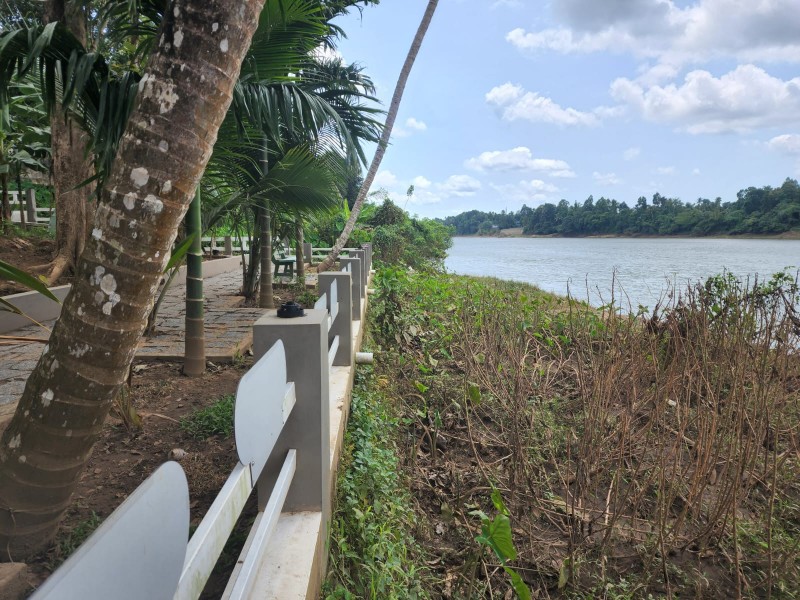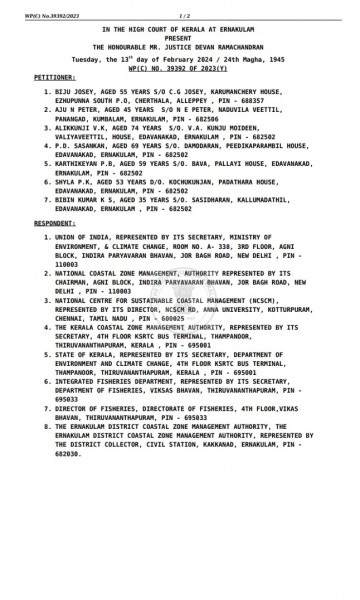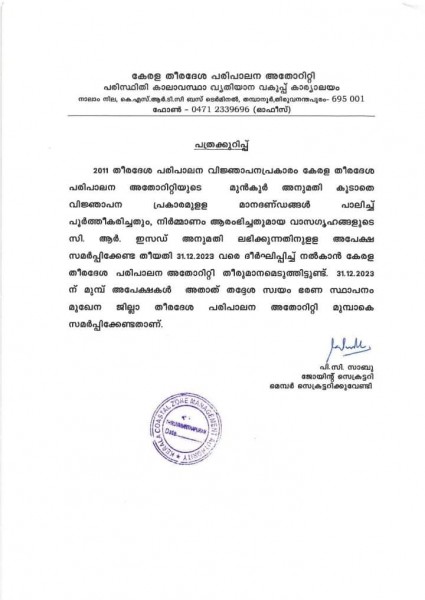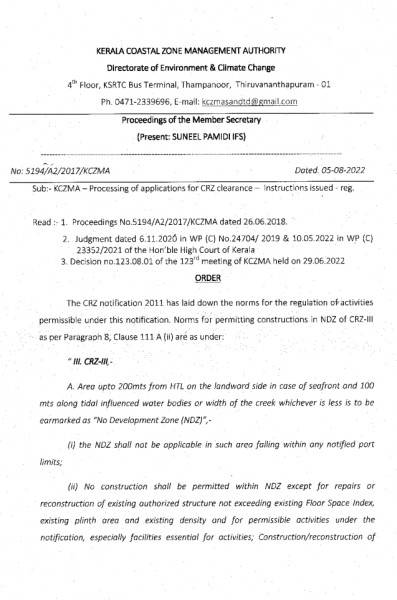Article
BLOWING HOT AND COLD ABOUT THE CRZ II STATUS OF 109 GRAMAPANCHAYATHS !
BLOWING HOT AND COLD ABOUT THE CRZ II STATUS OF 109 GRAMAPANCHAYATHS !
(CRZ 2019- CZMP IN KERALA)
Sherry J Thomas
sherryjthomas@gmail.com
The history of regulation
A great many local inhabitants are facing hardships for construction of their dwelling houses due to regulations in connection with coastal regulation zone notifications (CRZ) time to time. Obviously, first CRZ Notification came in the year 1991 and thereafter 2011 and finally in January, 2019. As per the provisions of the Notification, unless and until Coastal Zone Management Plans (CZMP) is prepared, the existing Notification will prevail and the benefits of the new Notification will not be made available to the public. As on today, the prevailing Notification for regulation of building permits is of CRZ 2011 Notification by the erstwhile Ministry on 6.1.2011.
Relaxation in regulations
During the pendency of erstwhile notification, Ministry received representations from various Coastal States and Union Territories besides other stakeholders and accordingly a committee was constituted under the Chairmanship of Dr Shailesh Nayak to examine various issues and concerns of coastal States and to recommend appropriate changes in the said Notification. Thereafter upon the recommendations, several changes were carried out the in the 2011 Notification and a new Notification CRZ 2019 is issued in supersession of the Coastal Regulation Zone Notification 2011. Despite of the same, the benefits of CRZ 2019 Notification is not available to the coastal people, for the reason that, as per the clause 6 in the CRZ notification 2029, it will be implemented only on preparation of Coastal Zone Management Plan (CZMP) which is not yet prepared.
Which read so-
Clause 6: Coastal Zone Management Plan (CZMP) ŌĆō (i) All coastal States and Union territory administrations shall revise or update their respective coastal zone management plan (CZMP) framed under CRZ Notification, 2011 number S.O. 19 E, dated 6th January, 2011, as per provisions of this notification and submit to the Ministry of Environment, Forest and Climate Change for approval at the earliest and all the project activities attracting the provisions of this notification shall be required to be appraised as per the updated CZMP under this notification and until and unless the CZMPs is so revised or updated, provisions of this notification shall not apply and the CZMP as per provisions of CRZ Notification, 2011 shall continue to be followed for appraisal and CRZ clearance to such projects.
Now the state of affairs in Kerala is that, all the activities in crz areas are halted due to the pendency of finalization of CZMP. Obviously that the non-completion of finalization process of CZMP for the CRZ Notification 2019 which is published on January 2019 is not because of the fault of the Coastal people.
Applicability of zone II
The regulations in coastal regulations on notification will vary on the basis of the particular zone in which the land is categorised. If the land is in CRZ zone II category, constructions are permissible on the landward side of existing authorised structure or existing Road. Ipso facto, if a local body is included in CRZ II category in the coastal zone management plan, they can claim this benefit. It is true that no where in the notification, the categorisation is fixed on identification of local body; whereas, it is on the basis of the fact that whether the local body comes under the category of 'legally designated urban area'.
In order to include many coastal panchayats under this category for minimising the regularisation, the State Government issued an order dated 6.10.21 by exercising powers conferred by Rule 3(6) of the Kerala Panchayath Building Rules 2019 notifying several Grama panchayaths as Category I Village Panchayaths. The CRZ II category is meant for the legally designated urban area and those panchayats in CRZ area falls under the 175 Coastal Grama Panchayaths, will be treated as legally designated urban area. Many of the coastal panchayats in Kerala is included in the list of 175 panchayaths. The Expert Committee Constituted by State Government recommended to categorize 175 Coastal Panchayaths as CRZ II Category. There are criticism on this point that under the guise of enabling the right to home of coastal inhabitants, now the state government is opening the coastal area to all commercial activities respective whether they are local inhabitants or coastal community and it will dilute the purpose of regulation itself. At the same time there are arguments that right to property is a constitutional right and by way of this notification, this right is being curtailed for more than three decades and therefore the coastal people eligible to use their land like any other land holder in the country.
The list 175 vs 66
As a matter of fact, ine order to avail the benefit of CRZ II for many of the coastal panchayats, the Government of Kerala made a representation to the NCZMA (National Coastal Zone Management Authority) related to CZMP (Coastal Zone Management Plan) pointing out that the term ŌĆślegally designated urban areasŌĆÖ is not defined under CRZ Notifications and therefore the ŌĆśUrban AreasŌĆÖ designated by the Acts or Rules or the Census Towns may be considered as ŌĆślegally designated urban areasŌĆÖ for the purpose of CRZ Notification. However NCZMA vide Agenda No.4.6 of 45th meeting held on 1.7.2022 recommended that only 66 Category I Coastal Grama Panchayaths notified before the issue of CRZ Notification 2019 be considered for the approval by the Ministry as Other existing legally designated urban areas as CRZ Notification 2019; i.e.; existing as on the date of issue of CRZ Notification 2019. The rest 109 Panchayaths were not included in the list.
There is no reasoning for considering classification as on the date of issue of CRZ 2019 Notification.
The Agenda No. 4.6 read so ŌĆō
Undisputedly, as per clause VI of the CRZ 2019 notification unless and until CZMP is prepared for CRZ 2019, the said notification cannot be implemented and existing CZMP of 2011 Notification is prevailing. Therefore the question to be mooted is that, even now the CZMP of 2019 Notification is not implemented and the date of urbanization has to be calculated from the date of finalization of CZMP not on the date of issue of CRZ 2019 Notification. If that is considered, the rest of 109 Gramapanchayaths are eligible for that count.
Yet another aspect is that, the guidelines for preparation of CZMP is published as Annexure IV of CRZ Notification 2019. The Paragraph 5 of the Guidelines dealt with classification of CRZ Areas. It is unambiguously stated that the verification shall be based on the latest satellite imagery and ground truthing.
The authorities cannot blow hot and cold as against the right of coastal people. For implementing the New Notification, the authorities are saying that the CZM Plan is not yet ready and for considering the categorisation of local body which is imperative while preparing plan, they says present status of 109 panchayaths cannot be included as it was not in urban category at the date of CRZ notification. Trite law is that, the category available at the date of preparation /finalization of the CZMP, to be considered. The plan itself has to be revised every 5 years and the latest status of local bodies should be reflected, for a just consideration.
The relaxation in CRZ Notification 2019, on various aspects was notified with an intention to reduce the difficulties for local communities in construction of their homestead. The Shailek Nayak Committee which was specifically appointed for this purpose recommended to relax the restrictions and accordingly the distance of NDZ is reduced on various categories. Evidently in the CRZ 2019 Notification the NDZ is generally reduced 50 meters in case of water bodies other than sea.
Implementation of latest notification
The implementation of CRZ 2019 Notification will be effective only after the finalization of Coastal Zone Management Plan of the same. The guidelines for preparation of CZMP is published as Annexure IV of CRZ Notification 2019. The Guideline 3(v) says, classification of different coastal zones shall be done as per the CRZ Notification and standard national or international colour codes shall be used. Therefore it is clear that the classification of categories are to take place while preparation of CZM Maps and not as on the date of issue of Notification. The Paragraph 5 of the Guidelines dealt with classification of CRZ Areas. The land use plan of the area is to be considered. The Para 5(vii) is specific on the point that, ŌĆ£The existing authorized developments on the seaward side shall be clearly demarcatedŌĆØ. The revision of CZMP is also possible as per Para 7 of the Guidelines. It is stated that the verification shall be based on the latest satellite imagery and ground truthing. Therefore the denial of categorization of CRZ II in connection with 109 Panchayats cannot be construed as legal. The date of issue of Notification is not the criteria, whereas as the latest ground truthing and legal status has to be taken in to account.
Delay in finalizing coastal zone management plan
The State Government is bound to prepare the plan enabling construction of dwelling units of local inhabitants as per the latest documents. Any delay in preparation of such plan may will be prejudicial to the right to home coastal people. Comparatively lesser restrictions are incorporated in the 2019 Notification, with an intention to reduce the rigor of regulation so as to enable construction of houses for local inhabitants. In the new Notification, the NDZ is reduced to 20 metres in case of back water islands. The dwelling houses of local inhabitants are also permissible. Therefore, the coastal people are entitled to get the benefit of reduced distance rule in the latest notification. The Honourable Supreme Court in Trilok Chand V. State of Himachal Pradesh 2020 10 SCC 763 held in a case in Connection with Prevention of Food adulteration Act 1954, relied on a previous decision wherein was opined that, since the amendment was beneficial to the accused persons, it could be applied to earlier cases pending before the courts. In so far as the central amendment reduces the punishment for an offence, there is no reason why the accused should not have given the benefit of such reduced punishment. The rule of beneficial construction requires that even ex post facto law of such a type should be apply to mitigate the rigour of law. The principle is based on sound reason and common sense. This find support in the following passage from Craies on Statute law 7th Edition at pp 388-89-
ŌĆ£ A retrospective statute is different from an ex post facto statute. "Every ex post facto law...." said Chase, J., in the American case of Calder v. Bull "must necessarily be retrospective, but every retrospective law is not an ex post facto law. Every law that takes away or impairs rights vested agreeably to existing laws is retrospective, and is generally unjust and may be oppressive; it is a good general rule that a law should have no retrospect, but in cases in which the laws may justly and for the benefit of the community and also of individuals relate to a time antecedent to their commencement: as statutes of oblivion or of pardon. They are certainly retrospective, and literally both concerning and after the facts committed. But I do not consider any law ex post facto within the prohibition that mollifies the rigor of the criminal law, but only those that create or aggravate the crime, or increase the punishment or change the rules of evidence for the purpose of convictionŌĆ”ŌĆ” There is a great and apparent difference between making an unlawful act lawful and the making an innocent action criminal and punishing it as a crime." (Paragraph 6).
The Honourable Supreme Court also held in Nemi Chand V. State of Rajasthan 2018 17 SCC 448 amendment which is beneficial can be applied even with respect to earlier cases.
Therefore the NCZMA shall RECONSIDER the Agenda No.4.6 of 45th meeting dated 1.7.2022 on the basis of date of preparation of Coastal Zone Management Plan as per Annexure A IV guidelines so as to classify 175 Panchayats included in the Gov. Order as CRZ II category. It is also a matter of concern that the preparation of CZMP (Coastal Zone Management Plan) and classification of categories are on the basis of the latest satellite imagery and ground truthing as per Annexure IV guidelines published in CRZ 2019 Notification. Incorporation of necessary disaster management provisions and proper sanitation arrangements as per Clause 5.3 (ii)(a) of CRZ Notification will enable the coastal community to utilise their property for construction of dwelling houses even if it falls under no development zone (NDZ) of coastal regulation zone notification.
(This article is on the basis of latest updates as on 18.02.2024)

 ┬Ā┬Ā┬Ā┬Ā
┬Ā┬Ā┬Ā┬Ā



0 Comments
Leave a Reply